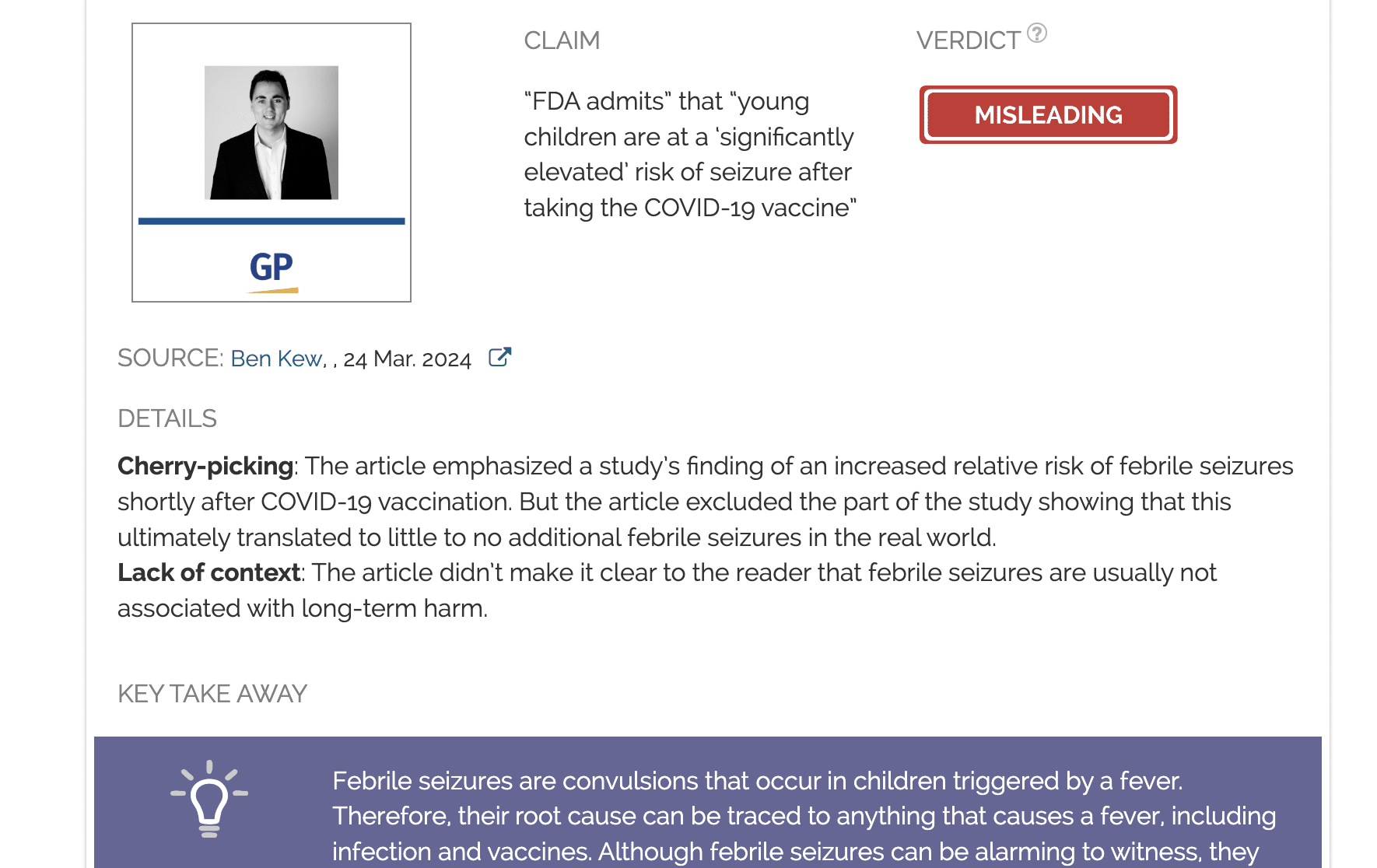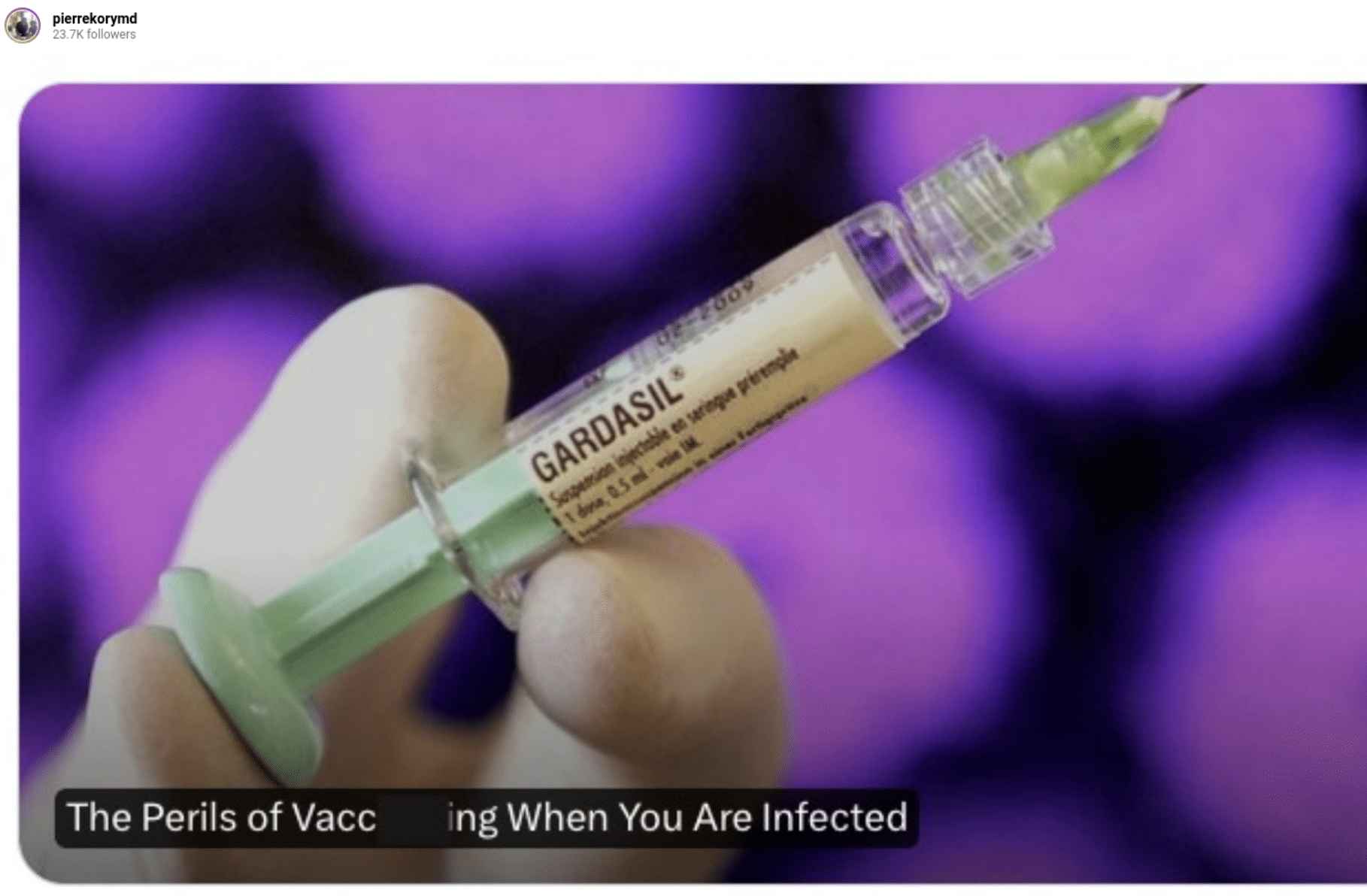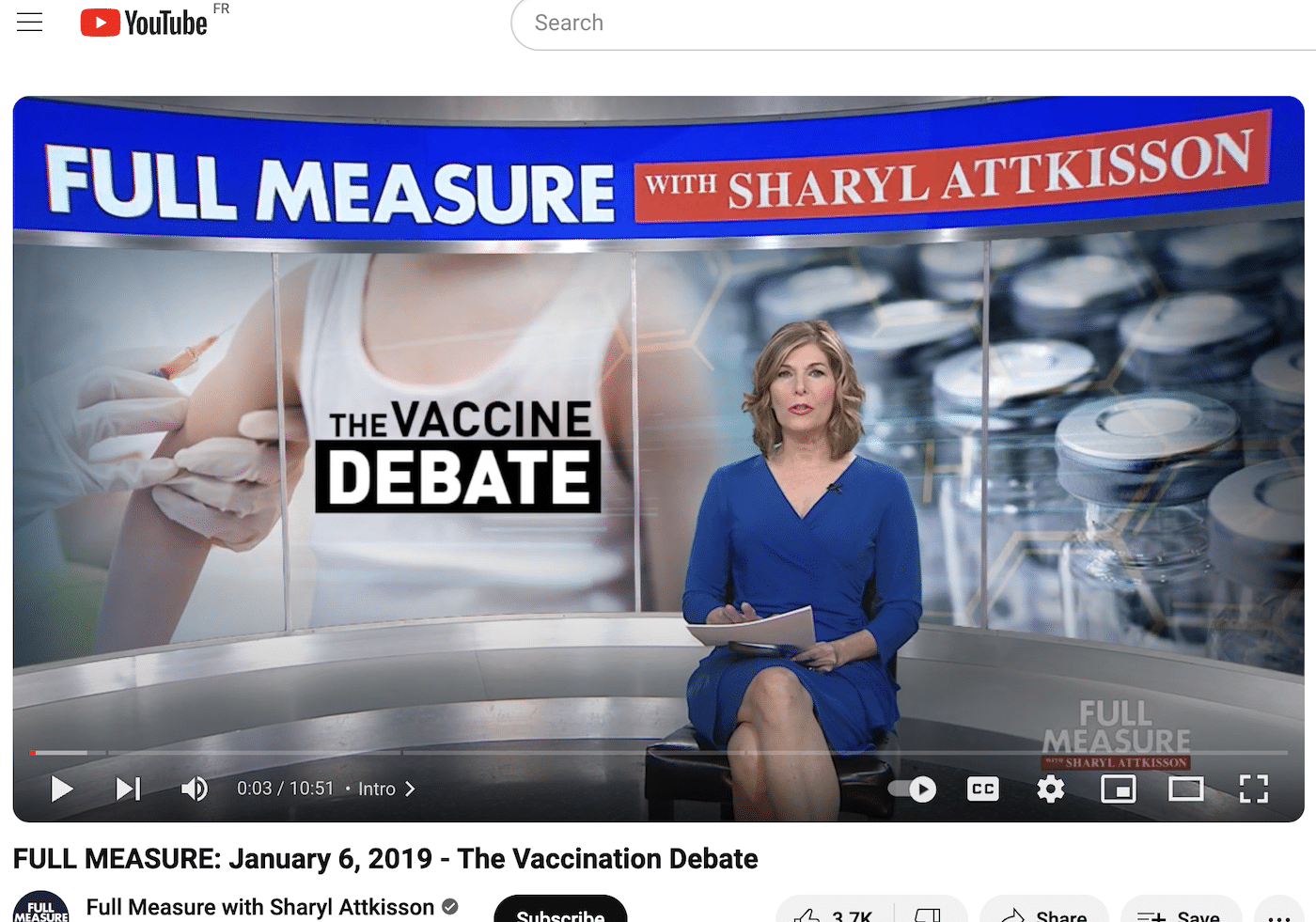- Health
Addressing false claims that Vitamin K shots have toxic levels of aluminum, Hepatitis B vaccines contain toxic ingredients, and more
Key takeaway
Newborns benefit from early vitamin K injection and childhood vaccines. Vitamin K is important to prevent spontaneous bleeding due to vitamin K deficiency, which is common at birth. Children can get Hepatitis B from their mothers or other children and are at a higher risk than adults of developing chronic infections and complications from the disease. The hepatitis B vaccine is safe and effective against the disease. None of their ingredients are toxic at the concentration used in the vaccines.
Reviewed content

Verdict:
Claim:
Vitamin K shots are dangerous because of toxic levels of aluminum; Hepatitis B vaccines contain toxic ingredients
Verdict detail
Factually inaccurate: Vitamin K shots only contain small amounts of aluminum, well below the tolerable exposure level indicated by the U.S. Food and Drug Administration.
Incorrect: The composition of the Hepatitis B vaccine doesn’t indicate that the vaccine is dangerous. The ingredients, including aluminum, formaldehyde, and yeast protein, are present in amounts well below the level for toxicity.
Full Claim
Vitamin K shots are dangerous because of toxic levels of aluminum; Hepatitis B vaccines contain toxic ingredients; Tylenol causes autism; hospitals aren’t a safe place to give birth
Review
A post shared on Instagram in December 2023 listed several health-related claims revolving around the idea that pediatricians and obstetricians aren’t to be trusted as they disseminate false information. We analyze several of these claims in this review.
Claim 1 (Inaccurate):
“My OB-GYN said vitamin k shot was just a vitamin, but it’s designed to make babies blood thicker in case of OB causing [brain] damage […] Aluminum content is 20,000 times MORE than the recommended dose, for adults !”
The claim that vitamin K shots are dangerous to neonates because they contain toxic levels of aluminum has appeared before, such as in this post by Children’s Health Defense, an anti-vaccine website that often disseminates vaccine disinformation. Similar claims have been reviewed in the past and found to be inaccurate.
Vitamin K is a fat-soluble vitamin essential for the synthesis of molecules involved in blood coagulation. In other words, vitamin K plays an important role in the body’s ability to form blood clotting to avoid bleeding. Sources of vitamin K include green leafy vegetables, as well as bacteria colonizing the human intestinal tract.
The American Academy of Pediatrics has recommended giving a vitamin K shot to newborn babies since 1961 to prevent vitamin K deficiency bleeding (VKDB)[1]. VKDB occurs when the body isn’t able to adequately form blood clots because of the lack of vitamin K and starts bleeding uncontrollably. Symptoms include bruises, paler skin than usual, and nose bleeds. The condition can be life-threatening when internal bleeding occurs, which can lead to brain damage and organ failure.
Babies are naturally born with low levels of vitamin K and their diet doesn’t provide them with external sources of that vitamin. Thus, they are particularly at risk of VKDB, which occurs in up to one in sixty newborns. One vitamin K injection at birth reduces by 81-fold the risk of suffering from VKDB.
Thus, contrary to the post, the vitamin K injection isn’t designed as a necessarily a safety measure against mistakes from obstetricians but to reduce the severity of any bleedings and prevent VKDB, a naturally occurring health condition.
The claim that vitamin K shots are dangerous because they contain 20,000 times the recommended amount of aluminum is inaccurate. The U.S. Food and Drug Administration (FDA) recommends that the total allowable exposure to aluminum through the intravenous route not exceed five micrograms per kilogram of body weight per day. One microgram is one thousandth of a milligram, or one millionth of a gram.
This means that the allowable aluminum exposure for a baby of an average weight at birth (three kilograms) is 15 micrograms per day.
Package information leaflets for vitamin K vials state that the vials contain no more than 100 micrograms of aluminum per liter. The leaflets cited above, as well as the vaccine information resource Vaxopedia indicate that newborns only get 0.5 milliliter of vitamin K solution. This means that they only receive 0.05 micrograms of aluminum through their vitamin K shot, at most. Thus, one vitamin K shot only contains 0.33% of the total allowable daily amount of aluminum.
Christine Gold, a pediatrician at UC Health University of Colorado Hospital, told USA Today that the vitamin K injection is “safe and life saving” and pointed out that “[a] baby who grows up to ever put his or her hand in their mouth, or whoever takes a bite of ice cream, will see more of those stabilizers/buffers at that time than all of the vaccines or vitamins we inject combined”.
Lena Claire van der List, a pediatrician at the University of California Davis, told the AFP that she has “zero concerns about the additives that are required to stabilize and effectively deliver this life-saving medication to newborns.”
Claim 2 (Incorrect):
“My OB said … Hep B was safe ! But Hep B vaccine: contains aluminum, yeast proteins, formaldehyde, salt, borax, proteins from Hep B virus”
We previously explained that Hepatitis B vaccines are safe and effective at providing long-term protection against the disease. Hepatitis B is believed by some as a purely sexually transmitted infection, suggesting that children aren’t usually exposed to it. However, this is a misconception.
Indeed, transmission can occur from the mother to the baby during pregnancy or birth. Child-to-child transmission is a major route of infection in regions with high HBV transmission because children are more likely to have contact with each other’s body fluids, such as saliva and tears.
While the list of ingredients presented in the claim is accurate, the claim that this makes the vaccine dangerous is incorrect.
Hepatitis B vaccines do contain some yeast proteins, because the vaccine’s manufacturing process involves baker’s yeast. However, the Children’s Hospital of Philadelphia explains that yeast proteins are only present in low amounts (one to five milligrams per milliliter) and that there is no data suggesting that they are dangerous.
The Hepatitis B vaccines also contain aluminum salts that are used as adjuvants. Adjuvants are substances added to the vaccine to enhance the immune response to the vaccine, thereby improving its effectiveness. Aluminum is progressively eliminated from the body through the kidneys and the level of aluminum exposure from diet and vaccines isn’t considered dangerous. In fact, children receive more aluminum from their diet than through vaccines. The Children’s Hospital of Philadelphia indicates that a baby receives about four milligrams of aluminum via vaccination during the first six months of life, but 7 to 117 milligrams through their diet.
The University of Oxford explains that formaldehyde is used to inactivate viral toxins present in the vaccine. Thus, formaldehyde actually serves to make the vaccine safer. Although high concentrations of formaldehyde are toxic, the amount present in vaccines is safe. In fact, formaldehyde is also naturally present in our body as it is essential for DNA synthesis. The amount of formaldehyde naturally circulating in the body is about 1,500 higher than the amount contained in vaccines received during childhood.
The fact that proteins from the Hepatitis B virus are listed among the supposedly toxic ingredients illustrates the lack of scientific understanding exhibited by the claim. Indeed, the whole idea of a vaccine is to contain harmless parts of a pathogen, in order to train the immune system to detect and target the pathogen in a future encounter. It is thus perfectly expected, and actually necessary, that proteins from the pathogen it targets are present in the vaccine.
Claim 3 (Unsupported):
“My OB said it was fine to take Tylenol while pregnant now they’re saying Tylenol is causing Autism and Asthma”
Health Feedback already reviewed that claim in a previous article. We found that currently available data on the association between Tylenol use and autism are inconclusive. In our previous review, we detailed the limitations of the scientific studies that had reported an association between Tylenol use during pregnancy and autism.
One limitation is that exposure to Tylenol isn’t controlled in these studies. This means that researchers are uncertain about how much Tylenol the mother took. Another is that some studies didn’t include a control group—a group of mothers who didn’t use Tylenol during pregnancy—so that it isn’t possible to establish a comparison.
Furthermore, focusing on the alleged risk of Tylenol overlooks the benefits of that drug. As we explained, alternatives to Tylenol for pain relief are non-steroidal anti-inflammatory drugs and opioids, both of which carry proven risks for pregnant women, unlike Tylenol.
Claim 4 (Misleading):
“My OB-GYN said it was safe to birth in a hospital but About 11,300 babies die within 21 hours after birth each YEAR in the United States!”
This claim appears to imply that it is safer to give birth outside of hospitals. We found that the figure cited in the claim appeared in a report from the non-profit organization Save the Children from 2013 finding that 11,300 babies die within 24 hours after birth in the U.S. However, these data are ten years old and more recent figures aren’t readily available. Thus, it’s worth pointing out that the claim relies on possibly outdated information.
This number of perinatal deaths is high compared to other industrialized countries and the report from Save the Children suggests that inequality in access to healthcare is part of the reason. However, this doesn’t mean that hospitals are more dangerous than other places to give birth. In fact, research showed that planned home births are associated with a higher risk of infant death, seizures and nervous system disorders than planned hospital births.
REFERENCES
- 1 – Hand et al. (2022) Vitamin K and the Newborn Infant. Pediatrics



